History
 Before the internet, people who wanted or needed to research a subject, for personal use or for schoolwork, had to go to the library, because they usually didn’t have the tools to research things at home, with the possible exception of a set of encyclopedias. I think many of us have had a physical set of encyclopedias, but those books had their own set of problems…the greatest being that they quickly became outdated. Of course, the internet has its own set of problems too…the greatest being misinformation and outright lies.
Before the internet, people who wanted or needed to research a subject, for personal use or for schoolwork, had to go to the library, because they usually didn’t have the tools to research things at home, with the possible exception of a set of encyclopedias. I think many of us have had a physical set of encyclopedias, but those books had their own set of problems…the greatest being that they quickly became outdated. Of course, the internet has its own set of problems too…the greatest being misinformation and outright lies.
All that aside, in the not-so-distant past, since it was still in my lifetime, research was done in the library, which is why so many schools had one of their own, at least in junior high and high school. The students, armed with a research subject went to the library and began their search. Basically, the library was the “internet” of the past. Your search would often begin with the card catalog. This was a large cabinet with very small drawers filled with cards with holes in the bottom that were attached to a rod in the bottom of the drawer. The cards were arranged alphabetically so they could be easily researched, but if the subject had a lot of information out there, that did not mean that the search would be a quick one.
Once the desired information was located, the researcher would use a slip of paper (usually provided by the  library) to write down the information the card gave as to the location of the book that housed the detailed information that had been summarized on the card. The card always contained a number such as 746.43, which was really a code for the location of the book needed by the researcher. In this case, the 7 stands for the classification…Art. The first 4 stands for the division…drawings/decorative arts. The 6 stands for the section…textile arts. The numbers following the decimal stand for classification within the section…type of textile. Armed with this information, the researcher was able to go to the section of the library that holds that classification of book and locate their book, or just as often they could go to the librarian and receive help to find their book. Of course, the biggest problem with this type of research is that the book might very likely be checked out already, especially if it was a popular subject. If the book wasn’t available, the researcher would have to wait until it came back or go start the whole process again to find another book that contained the desired information. As I’m sure you can imagine, this type of research was quite frustration, and extremely slow…especially if you had any inkling of the speed of locating information these days. Thankfully back then, no one did, so research papers were assigned weeks early, to be turned in at the end of the quarter or semester.
library) to write down the information the card gave as to the location of the book that housed the detailed information that had been summarized on the card. The card always contained a number such as 746.43, which was really a code for the location of the book needed by the researcher. In this case, the 7 stands for the classification…Art. The first 4 stands for the division…drawings/decorative arts. The 6 stands for the section…textile arts. The numbers following the decimal stand for classification within the section…type of textile. Armed with this information, the researcher was able to go to the section of the library that holds that classification of book and locate their book, or just as often they could go to the librarian and receive help to find their book. Of course, the biggest problem with this type of research is that the book might very likely be checked out already, especially if it was a popular subject. If the book wasn’t available, the researcher would have to wait until it came back or go start the whole process again to find another book that contained the desired information. As I’m sure you can imagine, this type of research was quite frustration, and extremely slow…especially if you had any inkling of the speed of locating information these days. Thankfully back then, no one did, so research papers were assigned weeks early, to be turned in at the end of the quarter or semester.
Once you had your hands on the desired book or a comparable alternative, you were required to read all or  most of the book to find the information you needed for your research project. You couldn’t simply ask the book a question and expect an answer like you can today with the computer and the internet. While today’s type of research is much easier, I’m sure there are many people who would say that the challenge of the “dig for information” is completely and sadly lost. I suppose they are right, but since I’m a techy, I would find that kind of research frustrating, since I do know about the computer and the internet. Thankfully, when I had to research information in my youth, I had no idea that the internet would exist in just a few short years, so the frustration was averted.
most of the book to find the information you needed for your research project. You couldn’t simply ask the book a question and expect an answer like you can today with the computer and the internet. While today’s type of research is much easier, I’m sure there are many people who would say that the challenge of the “dig for information” is completely and sadly lost. I suppose they are right, but since I’m a techy, I would find that kind of research frustrating, since I do know about the computer and the internet. Thankfully, when I had to research information in my youth, I had no idea that the internet would exist in just a few short years, so the frustration was averted.

 Shortages are usually problematic in one way or another, but sometimes they can be catastrophic, and sometimes, while not catastrophic, they can mean a really great loss. Shortages come in many forms, but when there is a shortage of something that is necessary, problems will result.
Shortages are usually problematic in one way or another, but sometimes they can be catastrophic, and sometimes, while not catastrophic, they can mean a really great loss. Shortages come in many forms, but when there is a shortage of something that is necessary, problems will result.
In the early 1980s, the world experienced a rather strange shortage…data tapes. This may seem rather benign kind of shortage. It seems like you could either just wait until more can be produced or come up with another way of recording the data. Well, that wasn’t the solution that NASA came up with. Their plan was to reuse data tapes that had outlived their usefulness. Some data tapes held data that was no longer important, and so NASA decided to use those data tapes for their temporary needs, until new data tapes could be procured.
The plan seemed like a good one and probably would have been, except that in their rush to find data tapes they could use, NASA accidentally recorded over the original Apollo 11 moon landing tapes. Unfortunately, these were the only copies of Apollo 11’s journey, and so a critical piece of human history was lost forever. In the 1990s, it was discovered that the Apollo 11 tapes were missing. This was a historical disaster, and an investigation was launched. Originally, NASA believed that the tapes were not lost forever as many claimed but stored somewhere in the Goddard Space Flight Center after the center requested that the National Archives return them in the early 1970s. It was determined the tapes had been erased and re-used during a data tape shortage during the early 1980s.
The lost footage brought about many claims of conspiracy theories, stating that man never walked on the moon at all. NASA finally released every photograph they had, but that didn’t really change people’s minds. They said it was all staged. It didn’t help matters, that the photos were very degraded. It seems like that is an ongoing 
 trend. Every disaster if followed by someone saying it didn’t happen. Now, I’m not saying it isn’t possible, I’m just saying that there will always be these conspiracy theories, and I just hope that at least most of our modern-day accomplishments really did happen, because the alternative would be awful. As to Apollo 11, it is just terrible that a shortage stole an important part of our history.
trend. Every disaster if followed by someone saying it didn’t happen. Now, I’m not saying it isn’t possible, I’m just saying that there will always be these conspiracy theories, and I just hope that at least most of our modern-day accomplishments really did happen, because the alternative would be awful. As to Apollo 11, it is just terrible that a shortage stole an important part of our history.
 In 1913, Milunka Savic joined the Serbian army in her brother’s place, cutting her hair and donning men’s clothes. You might wonder why she would do such a thing, and why her brother didn’t go and do his duty. This story isn’t about her heroics in the face of her brother’s cowardice, but rather her heroics when her brother truly could not serve. In 1912, Milunka’s brother received call-up papers for mobilization for the First Balkan War, but at the time, he was quite ill with tuberculosis. Milunka could have just told the authorities that he was ill, and he would have been excused, but she knew that the war effort was important, so she chose to go in his place. She started her transformation by cutting her hair and started wearing men’s clothes, then she joined the Serbian army. She saw combat almost immediately, and while many women of that era would have turned tail and run, she did not. She received her first medal and was promoted to corporal in the Battle of Bregalnica. While she was engaged in battle, Milunka was wounded, and as she was being treated in the hospital, her true gender was discovered by some very surprised physicians. I suppose you could say that she hadn’t thought this part of the plan out very well, or maybe she just didn’t plan to be wounded!! Nevertheless, here she was, and she had a problem.
In 1913, Milunka Savic joined the Serbian army in her brother’s place, cutting her hair and donning men’s clothes. You might wonder why she would do such a thing, and why her brother didn’t go and do his duty. This story isn’t about her heroics in the face of her brother’s cowardice, but rather her heroics when her brother truly could not serve. In 1912, Milunka’s brother received call-up papers for mobilization for the First Balkan War, but at the time, he was quite ill with tuberculosis. Milunka could have just told the authorities that he was ill, and he would have been excused, but she knew that the war effort was important, so she chose to go in his place. She started her transformation by cutting her hair and started wearing men’s clothes, then she joined the Serbian army. She saw combat almost immediately, and while many women of that era would have turned tail and run, she did not. She received her first medal and was promoted to corporal in the Battle of Bregalnica. While she was engaged in battle, Milunka was wounded, and as she was being treated in the hospital, her true gender was discovered by some very surprised physicians. I suppose you could say that she hadn’t thought this part of the plan out very well, or maybe she just didn’t plan to be wounded!! Nevertheless, here she was, and she had a problem.
She could have been in a lot of trouble at this point, but she had proven to such a competent soldier, her commanding officers were hesitant to punish her. It was decided that they would send her to a nursing division, but Milunka informed them that she would serve her country only in combat. This had to be an amazing woman, who was far ahead of her time in the area of women in combat. While they could have insisted, I suppose they would have also lost not only a nurse, but a great soldier, so they relented, and she went back to her unit. Milunka went on to fight in three wars and earn seven medals, including the Croix de Guerre and the British medal of the Most Distinguished Order of Saint Michael. It is believed that she may in fact be the most-decorated female combatant not only in Serbia, but in the entire history of warfare. To me, Milunka Savic was not just a hero for her fighting efforts, but for stepping up when her brother could not. I’m sure he is quite proud of his sister.
She was demobilized in 1919, and turned down an offer to move to France, where she was eligible to collect a comfortable French army pension. Milunka found work as a postal worker in Belgrade. In 1923, she married Veljko Gligorijevic, whom she met in Mostar, and divorced immediately after the birth of their daughter Milena. She loved children and went on to adopt three other daughters. In the interwar period, Milunka was largely forgotten by the general public. Life was not easy for her. She worked several menial jobs up to 1927, after which she had steady employment as a cleaning lady in the State Mortgage Bank. Eight years later, she was promoted to cleaning the offices of the general manager…such menial labor for a hero.

During the German occupation of Serbia in World War II, Milunka refused to attend a banquet organized by Milan Nedic, which was to be attended by German generals and officers. She was arrested and taken to Banjica concentration camp, where she was imprisoned for ten months. By the late 1950s, her daughter became ill, and before long she found herself living in poverty. In 1972, public pressure and a newspaper article highlighting her difficult housing and financial situation led to her finally receiving the recognition she deserved. She was given a small apartment by the Belgrade City Assembly. She died in Belgrade on October 5, 1973, at the age of 85, and was buried in Belgrade New Cemetery.

 When people allow fear to enter into their thinking, unfortunate and sometimes horrific things can happen. That really was the case, I believe, with the American settlers and the Native Americans. I’m not saying that the treatment of the Indians was without blame, because that is just not the case, but the wars that took place left the American settlers afraid of the Indians, and some people even decided that we needed to basically, “teach it out of them” or change the way the children thought so we could change a generation. It sounds a lot like what is being attempted in our schools today, if you ask me.
When people allow fear to enter into their thinking, unfortunate and sometimes horrific things can happen. That really was the case, I believe, with the American settlers and the Native Americans. I’m not saying that the treatment of the Indians was without blame, because that is just not the case, but the wars that took place left the American settlers afraid of the Indians, and some people even decided that we needed to basically, “teach it out of them” or change the way the children thought so we could change a generation. It sounds a lot like what is being attempted in our schools today, if you ask me.
For over a century, the US government actually went in and took Native American children from their families and forced them to attend Indian boarding schools. The idea was to separate the Indian traditions, language, and culture from these children, so they would become a “man worth saving,” because they thought the Indians had no value. They even recruited the missionaries in their endeavor, with the passing of the Civilization Fund Act of 1819, which encouraged missionaries to educate Native American children in the ways of the white man. In reality, this plan set the stage for eventual forced removal of children from their parents, so the parents could no longer have a say in their education, or an influence in their lives. In 1879, Captain Richard Henry Pratt opened the Carlisle Indian Industrial School. The whole purpose of the school, according to Pratt, was to “kill the Indian, and save the man.”
The schools mistreated the children, because they didn’t want to comply, didn’t understand what was asked of them, or they were just plain scared. Scholar Margaret Archuleta explained, “Not only were children removed from their parents, often forcibly, but they had their mouths washed out with lye soap when they spoke their Native languages.” A 1902 government order even argued long hair and other traditional customs slowed “the advancement they are making in civilization.” These poor children were stripped of their heritage, their families, their traditions, and their right to live a free life of their own choosing.
You might think that this barbaric act was something that was practiced just in the early days of this country and into the Indian Wars era, but these boarding schools actually continued until 1978!! At that time, Congress 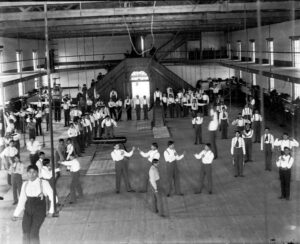
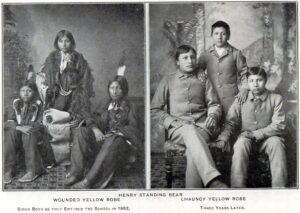 finally passed the Indian Child Welfare Act, which also addressed the practice of forcible adoption of Native American children. From that time on, Native American families were once again able to practice their own traditions and culture and speak their own language. I wonder just how much of their heritage was lost forever in the 159 years that the children spent in the custody of the American government.
finally passed the Indian Child Welfare Act, which also addressed the practice of forcible adoption of Native American children. From that time on, Native American families were once again able to practice their own traditions and culture and speak their own language. I wonder just how much of their heritage was lost forever in the 159 years that the children spent in the custody of the American government.
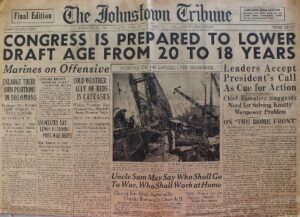 Before the summer of 1971, a person had to be 21 years old in order to vote. That was before the 26 Amendment was signed into law, on July 5, 1971, by President Richard Nixon. The amendment had passed through the Senate, House, and states in record time, lowered the voting age from 21 to 18, but it was not a quick victory. The battle was hard-fought, mostly by young people between the ages of 18 and 21, who were eligible to be drafted, but didn’t have the right to vote. The battle had raged since World War II.
Before the summer of 1971, a person had to be 21 years old in order to vote. That was before the 26 Amendment was signed into law, on July 5, 1971, by President Richard Nixon. The amendment had passed through the Senate, House, and states in record time, lowered the voting age from 21 to 18, but it was not a quick victory. The battle was hard-fought, mostly by young people between the ages of 18 and 21, who were eligible to be drafted, but didn’t have the right to vote. The battle had raged since World War II.
When the United States joined in the World War II war effort, it didn’t take long to find that they were going to need more men. It wasn’t that so many were killed, although that certainly was a problem too, but less than a year in, President Roosevelt and his administration faced a serious dilemma. They had 20 million eligible men who were registered for the draft, but 50% of them were rejected either for health reasons or because they were deemed illiterate. The United States had to have more men, and there was only one place to get them…expand the eligible draft ages. So, on November 11, 1942, Congress approved lowering the minimum draft age to 18 and raising the maximum to 37. Soon after, the slogan “Old enough to fight, old enough to vote” was born. For the over 21 draftees, the right to vote was already theirs, but the 18 to 20 year olds did not, and they felt like if they could be asked to fight and die, they should be able to vote…like ither adults, and much like the fight we have today with “old enough to fight, old enough to drink.” I’m not sure the current protestors will win their battle, however.
The changing of the voting age didn’t come easy either. Many people thought that 18-year-olds were just too young to understand politics. West Virginia congressman Jennings Randolph became the first supporter for lowering the age. In 1942, he introduced the first of 11 bills he sponsored over his tenure in Congress. Despite support from First Lady Eleanor Roosevelt and a number of senators and representatives, Congress failed to pass any legislation. Nevertheless, a popular movement was growing. Finally, in 1943, Georgia became the first  state to lower the voting age for state and local elections to 18, with Kentucky following suit in 1955. It broke the ice. While these young voters couldn’t vote for US offices, they had a say in their own state. The movement to lower the voting age began to gain grassroots traction when newly elected President Dwight D Eisenhower expressed his support in his 1954 State of the Union address, “For years our citizens between the ages of 18 and 20 have, in time of peril, been summoned to fight for America. They should participate in the political process that produces this fateful summons. I urge Congress to propose to the States a constitutional amendment permitting citizens to vote when they reach the age of 18.”
state to lower the voting age for state and local elections to 18, with Kentucky following suit in 1955. It broke the ice. While these young voters couldn’t vote for US offices, they had a say in their own state. The movement to lower the voting age began to gain grassroots traction when newly elected President Dwight D Eisenhower expressed his support in his 1954 State of the Union address, “For years our citizens between the ages of 18 and 20 have, in time of peril, been summoned to fight for America. They should participate in the political process that produces this fateful summons. I urge Congress to propose to the States a constitutional amendment permitting citizens to vote when they reach the age of 18.”
While it was gaining momentum, it was still slow-going. It would not be until much of the American public became disillusioned by the lengthy and costly war in Vietnam in the mid 1960s that the movement to lower the voting age gained widespread public support. “Old enough to fight, old enough to vote” found its way back into the American consciousness in the form of protest signs and chants. The push was revived, and then-Senator Randolph and other politicians continued to push legislation to lower the age to 18, including passing an amendment into 1965’s Voting Rights Act in 1970 that applied lowering the age to federal, state, and local elections. As the amendment was being signed into law, President Nixon thought it might be problematic. He issued a public statement that the federal government regulating state and local elections was likely to be “deemed unconstitutional and that only an amendment would secure this right.” He was right, and the amendment was struck down in the 1970 Supreme Court case Oregon v. Mitchell, ruling that the federal government could not make mandates for state and local elections. That meant that the fight continued. The initial result was a mixed system in which state and local elections had different rules than federal elections. That brought with it logistical problems on election days in states across the country, bringing more protests and lobbying efforts. The biggest problem was the 18 to 20 year olds worrying that their draft numbers were being called despite having no say in electing their representation. “Project 18” continued to put the pressure on legislators to take action. Marches were held all over the nation.

Finally, their hard work paid off. On March 10, 1971, the Senate voted unanimously in favor of a Constitutional amendment lowering the voting age to 18, followed by an overwhelming majority of the House voting in favor on March 23, 1971. The states quickly ratified the amendment, and it took effect on July 1, 1971, nearly 30 years after Senator Randolph first proposed lowering the voting age. In response to its passing, the senator remarked, “I believe that our young people possess a great social conscience, are perplexed by the injustices which exist in the world and are anxious to rectify these ills.” Finally, those who were “old enough to fight” could also vote.
 While many people have heard about the sinking of the German ship, The Bismarck, many may not have known that the Bismarck had a sister ship called the Tirpitz. Both ships were quite likely the same level of severity of threat to the war effort, but the Tirpitz somehow didn’t stand out as much…possibly because of the song that was written called “Sink the Bismarck” by Johnny Horton, and the fact that the Bismarck sank the Royal Navy battleship, HMS Hood, and that was the sinking than was the first and last straw before the Bismarck was taken down.
While many people have heard about the sinking of the German ship, The Bismarck, many may not have known that the Bismarck had a sister ship called the Tirpitz. Both ships were quite likely the same level of severity of threat to the war effort, but the Tirpitz somehow didn’t stand out as much…possibly because of the song that was written called “Sink the Bismarck” by Johnny Horton, and the fact that the Bismarck sank the Royal Navy battleship, HMS Hood, and that was the sinking than was the first and last straw before the Bismarck was taken down.
Nevertheless, the Tirpitz, commissioned in 1941, posed a grave threat to Allied shipping too. The Tirpitz was the German Navy’s mighty 42,900-ton battleship that carried a main armament of eight 15-inch guns. The ship saw limited action, however, spending most of its war career in Norwegian waters where it posed a constant danger to Allied convoys that were bound for Russia. Because the ship was in those waters, the Allies were forced to maintain a large fleet in northern waters to guard against the Tirpitz and repeated attempts were made by both the Royal Air Force and Royal Navy to sink the menacing ship. During the short life of the Bismarck, the battleship sank one ship…HMS Hood, and then the Royal Navy took the ship down. The Tirpitz was a menace a bit longer, but it never actually sank a ship. It took part in a number of battles, mostly shoot at other ships, but sinking none. Still, the possibility was always there that the Tirpitz could take out ships belonging to the Allies.
The Royal Air Force tried to take out the Tirpitz before it even set sail, by bombing it in January of 1941 while it  was being completed in a Wilhelmshaven dry dock. Somehow, the bombs actually “straddled” the battleship, missing it, and doing very little damage. Tirpitz was attacked again later in 1941 by twin engined bombers and in April 1942, when it was located and attacked by Halifaxes and Lancasters. Unfortunately, no bombs found their target that time either. The Royal Navy also attempted to take down the ship on a number of occasions with miniature submarines and carrier-based aircraft. Those attacks hit their mark, but had little effect, because Tirpitz had a double layer of armor plating. Finally, British inventor, Sir Barnes Wallis, built a special bomb for the job. He had previously developed the bouncing bomb used in the Dambusters Raid, so his inventions were trusted. In 1944 he devised the “Tallboy,” a 12,030-pound weapon capable of piercing the Tirpitz’s armor plating.
was being completed in a Wilhelmshaven dry dock. Somehow, the bombs actually “straddled” the battleship, missing it, and doing very little damage. Tirpitz was attacked again later in 1941 by twin engined bombers and in April 1942, when it was located and attacked by Halifaxes and Lancasters. Unfortunately, no bombs found their target that time either. The Royal Navy also attempted to take down the ship on a number of occasions with miniature submarines and carrier-based aircraft. Those attacks hit their mark, but had little effect, because Tirpitz had a double layer of armor plating. Finally, British inventor, Sir Barnes Wallis, built a special bomb for the job. He had previously developed the bouncing bomb used in the Dambusters Raid, so his inventions were trusted. In 1944 he devised the “Tallboy,” a 12,030-pound weapon capable of piercing the Tirpitz’s armor plating.
The ship was doomed, and on November 12, 1944, thirty Lancasters took off from Scotland flying in clear weather flew at 1,000 feet to avoid early detection by enemy radar prior to rendezvousing at a lake 100 miles southeast of Tromso. The attacking force then climbed to bombing height of between 12,000 and 16,000 feet. The Tirpitz was sighted from about 20 miles away. The crew called for air cover…frantically, but no cover came. They were sitting ducks when the Lancasters passed over the last mountain and the fjord with the Tirpitz came into view. When the bombers were about 13 miles away, the Tirpitz began firing their anti-aircraft guns. They  were joined by shore batteries and two flak ships. It was not enough. The Lancasters released their bombs were released and waited thirty long seconds for the results. The first bombs narrowly missed the target, but then a great yellow flash burst on the foredeck and the Tirpitz was seen to tremble as it was hit by at least two Tallboys. Smoke shot up to about 300 feet and the ship had started to list badly. Then a tremendous explosion was heard as the ammunition stores magazine went up. The ship rolled over to port and capsized. After 10 minutes only the hull visible from the air. Approximately 1000 of her crew were killed. The attacking aircraft, all with only minimal damaged returned safely to base. The Tirpitz was gone…finally.
were joined by shore batteries and two flak ships. It was not enough. The Lancasters released their bombs were released and waited thirty long seconds for the results. The first bombs narrowly missed the target, but then a great yellow flash burst on the foredeck and the Tirpitz was seen to tremble as it was hit by at least two Tallboys. Smoke shot up to about 300 feet and the ship had started to list badly. Then a tremendous explosion was heard as the ammunition stores magazine went up. The ship rolled over to port and capsized. After 10 minutes only the hull visible from the air. Approximately 1000 of her crew were killed. The attacking aircraft, all with only minimal damaged returned safely to base. The Tirpitz was gone…finally.

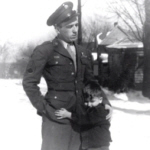 Veteran’s Day is a day about sacrifice and honor, duty and dedication, war and peace, but the day cannot pass for me without thoughts of my dad, and how much I miss him. I know I am not alone in these thoughts, because my sisters also miss him, as well as the rest of our family. My dad Staff Sergeant Allen L Spencer, fought in World War II, serving as flight engineer and top turret gunner on a B-17G Bomber. Dad came home after his successful service, which is why my sisters and I are alive, and why he was a veteran. A veteran is someone who served in the military and came home after.
Veteran’s Day is a day about sacrifice and honor, duty and dedication, war and peace, but the day cannot pass for me without thoughts of my dad, and how much I miss him. I know I am not alone in these thoughts, because my sisters also miss him, as well as the rest of our family. My dad Staff Sergeant Allen L Spencer, fought in World War II, serving as flight engineer and top turret gunner on a B-17G Bomber. Dad came home after his successful service, which is why my sisters and I are alive, and why he was a veteran. A veteran is someone who served in the military and came home after.
Soldiers really are a rare bread, created by God to go out and protect those who cannot protect themselves, even when those they protect don’t know or even care that it is a soldier who has watched over them, their borders, and their homes. The sacrifice a veteran gave was not about dying, although they will do that if it is what is required of them. The sacrifice of a veteran is being away from their family and friends. Some veterans miss out on their babies being born, their wedding anniversaries, weddings of family members, and so much more. They don’t know most of, if any of the people they are protecting, but they go anyway, because they are needed. Lives depend on their loyalty.
These men and women deserve our respect and that is what today is all about. It is a day to remind our veterans that we are grateful for their service, and happy that they were able to return to us and to their family members. War is a horrible thing, and no one really wants to be so far away from home fighting in a war they didn’t start, and one they wish hadn’t ever taken place. Unfortunately, evil exists in our world, and because it does, soldiers are a vital part of our security. God knew that soldiers would have to be people of honor and dedication, with a strong sense of duty and love for their fellow man. They would have to be people of courage and bravery…able to bite back the fear that dwells all around them. God knew the kind of people they would have to be…heroes. And that is what every veteran is, was, and always will be…a hero. Today is Veteran’s Day. It is a day to honor those who have given so much to keep us free. Thank you all for your great service. God bless you…every one of you.
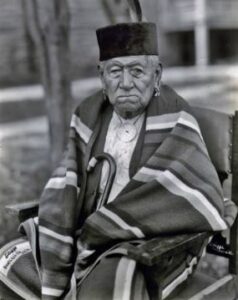
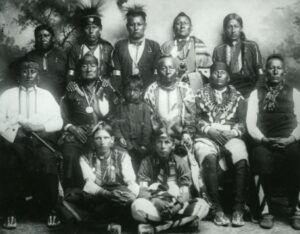 During the years when America was expanding very quickly, many Native American nations were placed on reservations, and the land they had previously lived on was taken from them…often by force, but sometimes by choice. Some Indians saw the writing on the wall and chose to go to the reservation so their people could survive. Those who didn’t found themselves in multiple battles that often ended in death.
During the years when America was expanding very quickly, many Native American nations were placed on reservations, and the land they had previously lived on was taken from them…often by force, but sometimes by choice. Some Indians saw the writing on the wall and chose to go to the reservation so their people could survive. Those who didn’t found themselves in multiple battles that often ended in death.
One group, the Osage Tribe made the decision to abandon their lands in Missouri and Aransas, giving it to the White Man’s Government, in exchange for the reservation in Oklahoma that was offered to them. I’m sure there were those within the tribe who were not happy with the decision that was made, but time would prove that it was the wisest decision to make. The decision made at that time, would later make them one of the wealthiest surviving Native American nations. The Osage Tribe was, at one time, the largest tribe of the Southern Sioux people. They occupied what are now the states of Missouri, Kansas, and Nebraska. This sophisticated tribe of people surprised the first Anglo explorers and settlers. When the settlers moved into the region, they found this Native American tribe living in more or less permanent villages made of sturdy earthen and log lodges. They really didn’t expect these people, whom they considered to be primitive, to be in such modern-day (for the times anyway) homes. The Osage Tribe is related to the Quapaw, Ponca, Omaha, and Kansa peoples. Like their cousins the Plains Indians, the Osage Tribe hunted buffalo and wild game, but they also raised crops to supplement their diets. They were really forward thinking, which was unusual for the times.
Americans found it much easier to understand and negotiate with the Southern Sioux, even though they often warred among themselves. They felt like they could understand the Southern Sioux much easier, because of their more sedentary ways…thing that the more nomadic Northern Sioux just didn’t make sense in that they just seemed to wander around. The White Man didn’t understand that kind of thinking. Maybe it was the more permanent homes offered by the American negotiators, that convinced the Osage Tribe to abandon their traditional lands and move peacefully to a reservation in southern Kansas in 1810. Unfortunately, that would not be the move that made the White Man happy, so when American settlers began to covet the Osage reservation in Kansas, the tribe agreed to yet another move, relocating to what is now Osage County, Oklahoma, in 1872.
While the American settlers found it easier to work with the Osage Tribe and the Southern Sioux, they were not always truly fair with them. The American settlers constantly pressured the government to push Native Americans off valuable lands and onto marginal reservations. Unfortunately, this practice was all too common throughout the history of western settlement. Most tribes were devastated by these relocations, including some of the Southern Sioux tribes like the Kansa, whose population of 1,700 was reduced to only 194 following their disastrous relocation to a 250,000-acre reservation in Kansas. Nevertheless, the Osage tribe, proved unusually 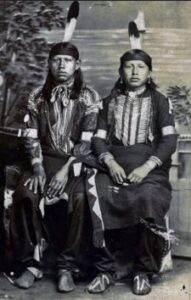
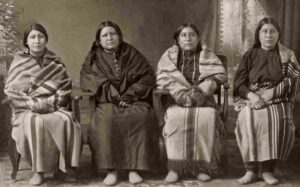 successful in adapting to the demands of living in a world dominated by Anglo-Americans. Of course, a big part of their success and wealth is due in part to the presence of large reserves of oil and gas on their Oklahoma reservation, as well as the effective management of the grazing contracts set up with the Anglos. During the twentieth century, the Osage amassed enormous wealth from their oil and gas deposits, eventually becoming the wealthiest tribe in North America.
successful in adapting to the demands of living in a world dominated by Anglo-Americans. Of course, a big part of their success and wealth is due in part to the presence of large reserves of oil and gas on their Oklahoma reservation, as well as the effective management of the grazing contracts set up with the Anglos. During the twentieth century, the Osage amassed enormous wealth from their oil and gas deposits, eventually becoming the wealthiest tribe in North America.

 I married into the Schulenberg family almost 48 years ago. During the early years, when we would make trips to Forsyth, Montana to visit my husband, Bob Schulenberg’s family that lived there. One such visit was for a family reunion. It was at that reunion, that I first met my father-in-law, Walt Schulenberg’s half-brother, Butch Schulenberg. For many years, I didn’t see Butch again, and then when my father-in-law passed away in 2015, we were making calls to tell family of his passing. I spoke to Uncle Butch, and it was such a nice, even while sad, call, that Uncle Butch became a very dear uncle to me. I love his kind heart and his caring ways. I think everyone loves Butch Schulenberg, because that is the kind of man he is.
I married into the Schulenberg family almost 48 years ago. During the early years, when we would make trips to Forsyth, Montana to visit my husband, Bob Schulenberg’s family that lived there. One such visit was for a family reunion. It was at that reunion, that I first met my father-in-law, Walt Schulenberg’s half-brother, Butch Schulenberg. For many years, I didn’t see Butch again, and then when my father-in-law passed away in 2015, we were making calls to tell family of his passing. I spoke to Uncle Butch, and it was such a nice, even while sad, call, that Uncle Butch became a very dear uncle to me. I love his kind heart and his caring ways. I think everyone loves Butch Schulenberg, because that is the kind of man he is.
Uncle Butch is a veteran, having served in the Army during the Vietnam War. He was a respected member of 
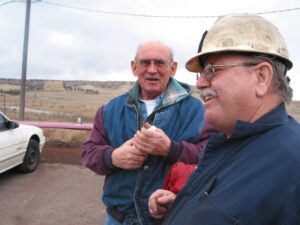 his company. Butch was chosen to be a driver for an officer. Butch told my husband, Bob and me several stories about his driving days in the service. He told us of so many interesting details that he was privileged to know, but at that time could not speak of. During war, the soldiers are very restricted on what information they can share, mostly because disclosing information could be a detriment to the whole company. Now that the war is long-over, the details of their operations are history…very interesting history. That is something Butch ad I have in common too…history. We both love the details of the past, and the impact they have had on the future. I am proud of his service. He is the kind of soldier this nation is blessed to have…and I’m very thankful he made it home.
his company. Butch was chosen to be a driver for an officer. Butch told my husband, Bob and me several stories about his driving days in the service. He told us of so many interesting details that he was privileged to know, but at that time could not speak of. During war, the soldiers are very restricted on what information they can share, mostly because disclosing information could be a detriment to the whole company. Now that the war is long-over, the details of their operations are history…very interesting history. That is something Butch ad I have in common too…history. We both love the details of the past, and the impact they have had on the future. I am proud of his service. He is the kind of soldier this nation is blessed to have…and I’m very thankful he made it home.
These days, Uncle Butch is busy enjoying his retirement, and going to visit his children and grandchildren. He 
 loves taking pictures around his house in Forsyth, Montana. He is a huge fan of the local school sports teams and goes to or listens to as many games as he possibly can. He is one of their biggest fans. He is very community oriented. He loves his small town and feels very connected to all the people there. He is very much a loved member of the community, and he loves all of them too. Today is Butch’s 82nd birthday. Happy birthday Butch!! Have a great day!! We love you!!
loves taking pictures around his house in Forsyth, Montana. He is a huge fan of the local school sports teams and goes to or listens to as many games as he possibly can. He is one of their biggest fans. He is very community oriented. He loves his small town and feels very connected to all the people there. He is very much a loved member of the community, and he loves all of them too. Today is Butch’s 82nd birthday. Happy birthday Butch!! Have a great day!! We love you!!
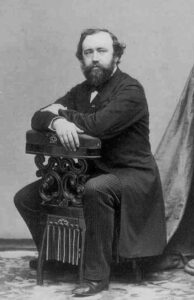
 Antoine-Joseph Sax was born on November 6, 1814, in Dinant, which is now part of Belgium, to Charles-Joseph Sax and his wife Marie-Joseph née Masson Sax. As a child, Antoine, nicknamed Adolphe was quite accident prone, and some say that it is a wonder he made it to his teenaged years, much less to adulthood.
Antoine-Joseph Sax was born on November 6, 1814, in Dinant, which is now part of Belgium, to Charles-Joseph Sax and his wife Marie-Joseph née Masson Sax. As a child, Antoine, nicknamed Adolphe was quite accident prone, and some say that it is a wonder he made it to his teenaged years, much less to adulthood.
As a boy, Sax faced many brushes with death. As a child, he once fell out a window from a height of three floors, hit his head on a stone and was believed dead. At the age of three, he drank a bowl full of acidic water, because it looked like milk to the boy. Later, he swallowed a pin. He received serious burns from a gunpowder explosion, and once fell onto a hot cast-iron frying pan, burning his side. Several times he avoided accidental poisoning and asphyxiation from sleeping in a room where varnished furniture was drying. Another time young Sax was struck on the head by a cobblestone and fell into a river, almost dying. His mother once said that “he’s a child condemned to misfortune; he won’t live.” His neighbors called him “little Sax, the ghost.”
Sax came from a musical family. His father and mother were instrument designers, who made several changes 
 to the design of the French horn. At an early age, Adolphe began to make his own instruments. At the age of 15 years, he entered two of his flutes and a clarinet into a competition. He went on to study performance on those two instruments, as well as voice at the Royal Conservatory of Brussels. Adolphe relocated permanently to Paris in 1842 and began working on a new set of valved bugles. As with the rest of his childhood, even the invention of the saxophone was an accident of sorts…being the result of a modified saxhorn he’d created with his father, Charles Joseph Sax, in 1845.
to the design of the French horn. At an early age, Adolphe began to make his own instruments. At the age of 15 years, he entered two of his flutes and a clarinet into a competition. He went on to study performance on those two instruments, as well as voice at the Royal Conservatory of Brussels. Adolphe relocated permanently to Paris in 1842 and began working on a new set of valved bugles. As with the rest of his childhood, even the invention of the saxophone was an accident of sorts…being the result of a modified saxhorn he’d created with his father, Charles Joseph Sax, in 1845.
While he did not invent what became known as saxhorns, his examples were much more successful than those of his rivals. Hector Berlioz, French Romantic composer and conductor was so enamored of Adolphe’s saxhorn examples, that he arranged in February 1844 for one of his pieces to be played entirely on saxhorns. The 
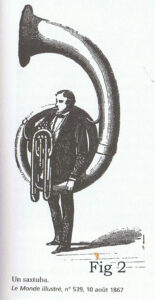
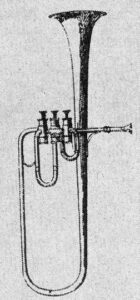 composition called for seven different sizes of saxhorns, and it was this composition that paved the way for the creation of the flugelhorn.
composition called for seven different sizes of saxhorns, and it was this composition that paved the way for the creation of the flugelhorn.
In 1845, Adolphe Sax also developed the saxotromba family, which were valved brass instruments bearing a narrower bore than the saxhorns. These were not as successful, and soon became a thing of the past. Sax went on to become an instructor at the Paris Conservatory. True to his earlier live of catastrophic events, Sax developed lip cancer in his later life, and true to his past, he survived that as well. Nevertheless, the catastrophic events continued, and Sax died of pneumonia in Paris, in relative poverty in 1894.

